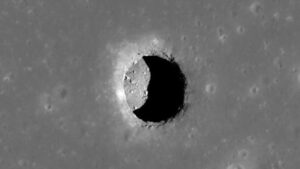Scientists have uncovered evidence that ice recently existed on the surface of Mars. The discovery comes in the form of a crusty scrim of salt demonstrating familiar glacial features, including moraines. It indicates that a real glacier once called Mars’ equatorial region home.
Scientists suggested that ash and pumice from nearby volcanoes could have produced the material that helped preserve the glacier.
“This region of Mars has a history of volcanic activity. And where some of the volcanic materials came in contact with glacier ice, chemical reactions would have taken place at the boundary between the two to form a hardened layer of sulfate salts,” study co-author Sourabh Shubhamof said in a press release.

Could this relict glacier be hiding ice that future Martian explorers could turn into drinking water? Photo: NASA MRO HiRISE/CRISM
Relict glaciers
Researchers are jazzed on the news because the salty, glacier-shaped deposit (called a “relict glacier”) doesn’t display many signs of erosion. That means it’s fairly new, in geologic terms.
“We’ve known about glacial activity on Mars at many locations, including near the equator in the more distant past. And we’ve known about recent glacial activity on Mars, but so far, only at higher latitudes,” said John Schutt, a geologist at the Mars Institute and another study co-author.
“A relatively young relict glacier in this location tells us that Mars experienced surface ice in recent times, even near the equator, which is new.”
The find could have powerful implications for humanity’s upcoming plans for manned Martian exploration. There are areas of South America where blankets of salt have preserved glacial ice underground — a phenomenon that the relict glacier on equatorial Mars could mimic.
“The desire to land humans at a location where they might be able to extract water ice from the ground has been pushing mission planners to consider higher latitude sites. But the latter environments are typically colder and more challenging for humans and robots. If there were equatorial locations where ice might be found at shallow depth, then we’d have the best of both environments,” said Pascal Lee, planetary scientist and lead study author.
Scientists must now determine how much ice, if any, lies preserved beneath the relict glacier.






